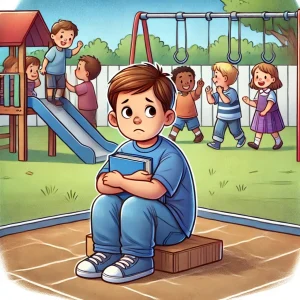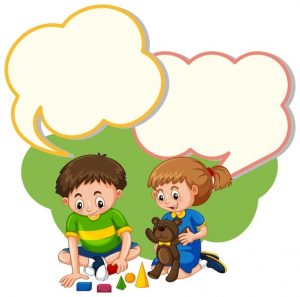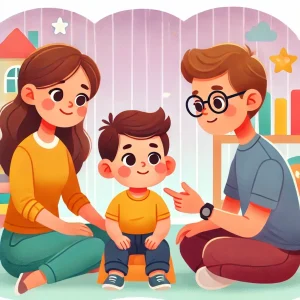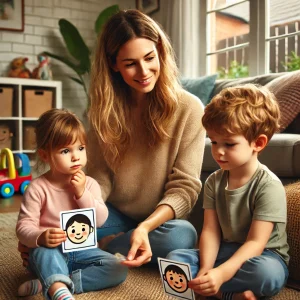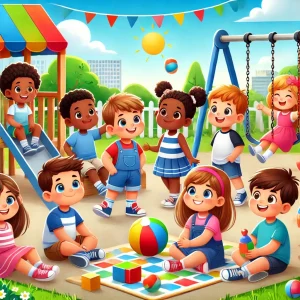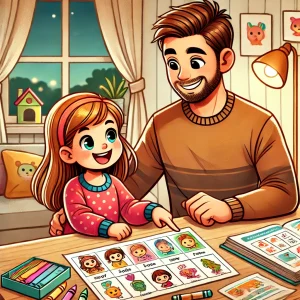How to Help Your Child Pronounce the “Ch” Sound
By Rajini D
Last Updated: April 18, 2024
Welcome to the journey towards clearer speech for your little one. As parents and guardians, our deepest wish is for our children to thrive in every aspect of their development. Among these, the ability to communicate clearly stands out as a cornerstone. Clear speech not only fosters effective communication but also bolsters confidence and social interactions, laying a robust foundation for lifelong learning and relationships.
However, the road to clear speech isn’t always smooth, especially when it comes to mastering specific sounds. Many parents observe their children grappling with the ‘CH’ sound, transforming words like ‘cheese’ into ‘tees’ with an innocent twist of the tongue. This common challenge can lead to moments of frustration and concern, both for children and their supportive families.
But here’s the heartening news: you’re not alone on this journey. Pronunciation hurdles, particularly with the ‘CH’ sound, are a shared experience for many families. And the better news? There are simple, effective strategies to navigate these hurdles, ensuring your child can express themselves with clarity and confidence.
Also Read: Help Kids Master the “CH” Sound – WellnessHub
Understanding the ‘CH’ Sound
Diving into the world of speech sounds, the ‘CH’ sound stands out as a unique blend that can sometimes puzzle our little learners. It’s like a magical mix of two sounds, the “t” and “sh,” that, when combined correctly, create the distinctive ‘CH’ sound we use in words like “chocolate,” “chair,” and yes, “cheese.”
But why do some children find this sound challenging to master? It all boils down to the intricate dance of tongue, teeth, and breath required to produce it. To say the ‘CH’ sound, the tip of the tongue needs to touch just behind the top front teeth, the teeth come close together, and then, with a little burst of air, the sound comes to life. It’s a complex coordination that children, especially those still finessing their speech skills, might find tricky.
A common substitution for the ‘CH’ sound among children is the simpler “t” sound. So, “cheese” becomes “tees,” and “chocolate” turns into “totolate.” This swap happens because the “t” sound is easier for little mouths to manage. It doesn’t require the same level of coordination between the tongue, teeth, and breath as the ‘CH’ sound does.
Also Read: Speech Therapy Strategies for Kids: Mastering CH Words
Key Steps to Mastering the ‘CH’ Sound
Embarking on the journey to master the ‘CH’ sound is much like assembling a puzzle — it’s about putting the right pieces together, step by step. Here’s how you can guide your child through this engaging process, turning learning into a fun-filled adventure.
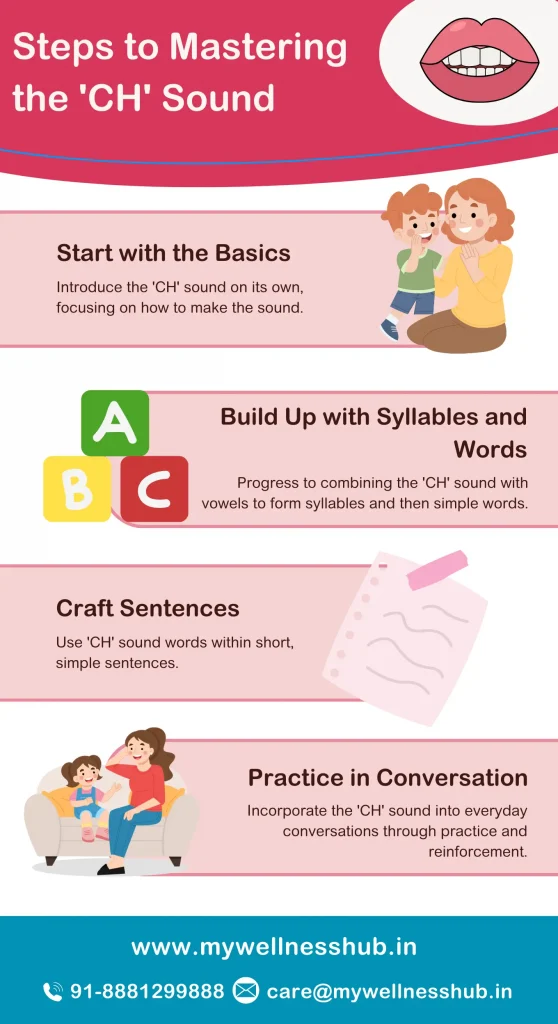
Starting with the Basics
The Importance of Isolating the ‘CH’ Sound for Practice:
To begin, it’s crucial to isolate the ‘CH’ sound, allowing your child to focus on the specific movement and coordination needed. Think of it as tuning a musical instrument before playing a symphony. Isolating the sound helps your child understand and reproduce it accurately.
Simple Exercises to Introduce the Sound:
- Mimic the Train: Use playful imagery, like a train chugging along, saying “ch-ch-ch” together. This not only makes the practice fun but also visually and audibly reinforces the sound.
- The Sneezing Game: Encourage pretending to sneeze using the ‘CH’ sound, turning it into a game. “A-CH-oo!” This exercise mimics the explosive nature of the sound, making it memorable and engaging.
Read more on our article Understanding Toddler Speech: Speech Milestones at 18 Months.
Building Up with Syllables and Words
Tips for Practicing ‘CH’ Sound in Syllables, Then Progressing to Words:
Begin with simple syllables like “cha,” “che,” “chi,” “cho,” and “chu.” Clapping hands with each syllable can add a rhythmic component to learning. As mastery develops, gradually introduce words that begin with the ‘CH’ sound, such as “chair,” “cheese,” and “cherry.”
Suggested Words List to Practice, Categorized by Difficulty Level:
- Beginner: Chair, cheese, cherry
- Intermediate: Kitchen, watching, lunch
- Advanced: Marching, crunchy branches
Crafting Sentences
Guidance on Forming Simple Sentences with ‘CH’ Sound Words to Enhance Fluency:
Once comfortable with words, challenge your child to build simple sentences, enhancing their fluency. Start with sentences like “The chair is red,” progressing to more complex ones such as “Charlie chooses cheese at lunch.”
Example Sentences to Get Started:
- “Chloe and Chase choose chocolate chips.”
- “The cheerful child changes channels.”
Practicing in Conversation
- Strategies for Incorporating the ‘CH’ Sound into Daily Conversations:
Encourage your child to use ‘CH’ sound words in everyday conversations. Whether it’s during mealtime or playtime, gently correct and guide them, making sure the practice is as natural and stress-free as possible. - Encouragement for Natural, Relaxed Practice:
Remember, the goal is to integrate smoothly into daily speech, not to put pressure on getting it perfect every time. Celebrate progress, no matter how small, and keep the atmosphere light and encouraging.
Wrapping Up
Mastering the ‘CH’ sound doesn’t have to be a chore. With these steps, you’re not just teaching your child how to articulate a sound; you’re turning to learn into an enjoyable journey. By isolating the sound, building up from syllables to words, crafting sentences, and integrating into conversation, you’re providing a comprehensive toolkit for success.
Common ‘CH’ Sound Words by Difficulty Level
| Difficulty Level | ‘CH’ Sound Words Examples | Notes |
|---|---|---|
| Beginner | Chair, Cheese, Cherry | These words are straightforward and typically among the first ‘CH’ sound words introduced to children due to their simplicity and common usage. |
| Intermediate | Kitchen, Watching, Lunch | These words contain the ‘CH’ sound in different positions (beginning, middle, end) and introduce complexity in syllable structure and context use. |
| Advanced | Marching, Crunchy, Branches | Advanced words often feature the ‘CH’ sound in conjunction with other sounds and may include blends or are part of longer, multi-syllable words. |
Know more: Improve Speech at Home: Easy Exercises & Fun Activities
Extra Tips for Success
Mastering the ‘CH’ sound is a journey filled with small steps and big leaps. To make this journey smoother and more enjoyable for your child, here are some extra tips and activities. Remember, the key ingredients are patience, positive reinforcement, and fun.
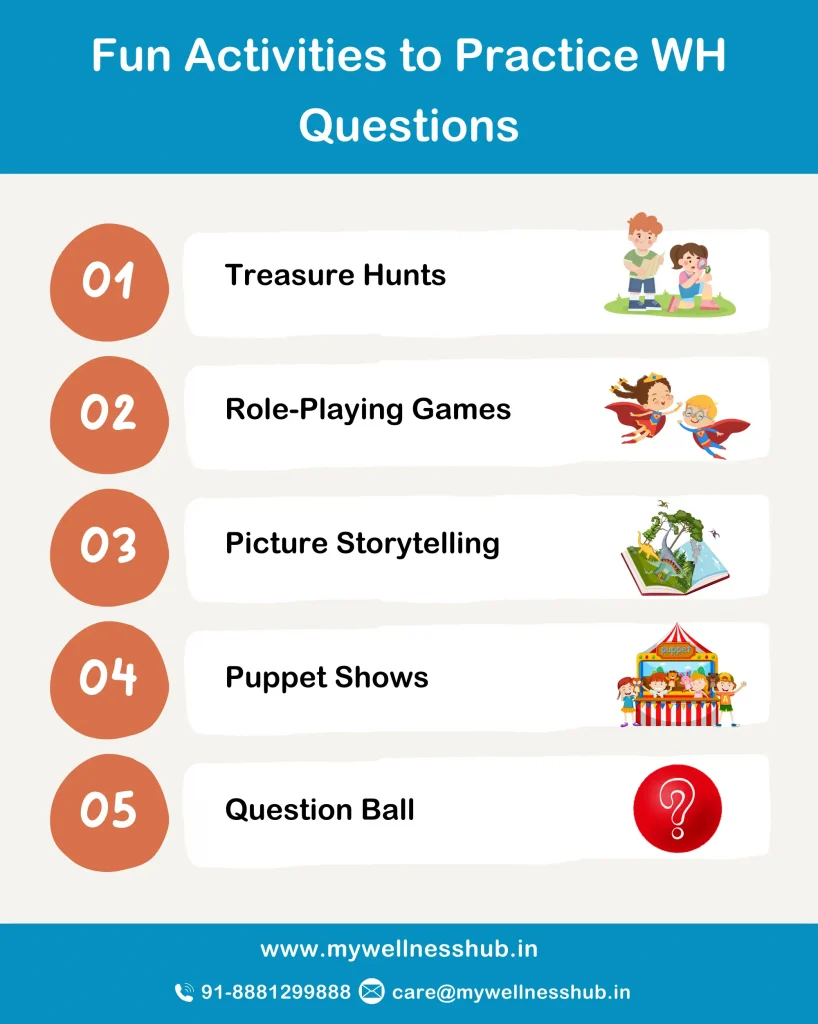
Emphasize Patience and Positive Reinforcement
- Celebrate Small Wins: Every correct ‘CH’ sound your child makes is a victory. Celebrate it! Positive reinforcement boosts their confidence and motivation.
- Stay Patient: Learning takes time. If your child struggles or makes a mistake, reassure them with kindness and patience. Remind them (and yourself) that every attempt, successful or not, is part of the learning process.
Fun Activities and Games Incorporating the ‘CH’ Sound
- ‘CH’ Sound Treasure Hunt: Create a treasure hunt at home with clues leading to objects that have the ‘CH’ sound in their names. This could be a chocolate bar, a toy chair, or a picture of a church. It’s a fun way to practice the sound in a real-world context.
- Craft with ‘CH’: Engage in arts and crafts related to things that start with ‘CH.’ You could make a paper chain, a model church, or even a chocolate chip cookie out of craft materials. While crafting, emphasize the ‘CH’ sound, repeating the words together.
- Story Time with ‘CH’: Pick books with characters or themes involving the ‘CH’ sound. After reading, discuss the story with your child, focusing on ‘CH’ words. You can even ask them to narrate parts of the story, emphasizing the ‘CH’ sound to reinforce learning.
- Sing-Along ‘CH’ Songs: Create or find songs that feature plenty of ‘CH’ sounds. Singing together can be a delightful way to practice the sound, improving pronunciation while having fun.
- ‘CH’ Sound Bingo: Make a bingo game with cards that have pictures or words with the ‘CH’ sound. Play together, saying each word out loud. This not only makes practicing fun but also introduces new vocabulary.
Making Every Moment a Learning Opportunity
- Incorporate Practice into Daily Routines: Use meal times, bath times, or car rides as opportunities for casual practice. For instance, ask your child to choose the ‘CH’eese during lunch preparation or find the ‘CH’urch while driving.
- Lead by Example: Use the ‘CH’ sound frequently and correctly in your conversations. Children learn a lot by imitation, so hearing the sound used correctly helps them understand its application.
Remember, the goal is not just mastering a sound; it’s about nurturing a love for learning and communication. By integrating these tips and activities into your routine, you’re not only helping your child, but also encouraging them to explore and enjoy the world of words.
When to Seek Professional Help
As we navigate the path of supporting our children’s speech development, it’s essential to recognize when they might benefit from professional guidance. While many children face challenges with sounds like ‘CH,’ certain signs may indicate the need for specialized support. Understanding these signs ensures that any underlying issues are addressed in a timely, fostering your child’s speech and overall development.
Signs Indicating the Need for Professional Assistance:
- Age Considerations: If your child is significantly older than the typical age range (around 4 to 5 years old) for mastering the ‘CH’ sound and still struggles with it, it might be time to consult a professional.
- Frustration and Avoidance: Notice if your child becomes noticeably frustrated when trying to pronounce ‘CH’ sounds or starts avoiding words that contain them. This could be a sign they’re struggling more than they should.
- Impact on Communication: When difficulties with the ‘CH’ sound (or any other speech sound) begin to impact your child’s ability to communicate effectively, professional advice can be invaluable.
- Speech Clarity Issues: If your child’s speech clarity isn’t improving and the ‘CH’ sound is just one of several pronunciation challenges they’re facing, seeking a speech therapist’s input can help.
- Concerns from Educators: Feedback from teachers or childcare providers about your child’s speech development can also be a cue. Educators are skilled at noticing when a child’s speech patterns diverge significantly from developmental norms.
Signs Your Child May Need Professional Help
| Sign | Action Suggested | Additional Information |
|---|---|---|
| Struggling beyond age 5 | Consult a speech therapist | By age 5, most children have mastered the ‘CH’ sound. If your child is still struggling, a speech therapist can provide targeted strategies and support. |
| Noticeable frustration or avoidance | Seek guidance for emotional support. | Children who show signs of frustration or avoid speaking may feel self-conscious about their speech. Emotional support and professional guidance can help build confidence. |
| Speech clarity not improving | Professional evaluation recommended | If there’s little to no improvement in speech clarity despite practice, a professional evaluation can identify underlying issues and offer a tailored intervention plan. |
| Feedback from educators | Explore speech therapy options. | Teachers and educators can often provide insights into a child’s speech development in a learning environment. Their feedback can indicate a need for further assessment and possible therapy. |
How Wellness Hub Can Assist:
Recognizing these signs early and deciding to seek professional help is a proactive step toward supporting your child’s speech journey. At Wellness Hub, we’re here to connect you with a network of speech therapy resources. Our platform offers access to experienced speech-language pathologists who specialize in pediatric speech development. They can provide personalized strategies and interventions tailored to your child’s needs, ensuring they receive the support necessary to thrive.
Supporting Your Child Beyond the ‘CH’ Sound
As we explore the journey to clear speech, it’s crucial to remember that mastering the ‘CH’ sound is just one piece of the vast puzzle of speech development. True clarity in communication comes from a holistic approach that nurtures all aspects of your child’s ability to express themselves. This means engaging with a variety of sounds, words, and the nuances of language that make communication rich and rewarding.
Embracing a Holistic Approach to Speech Clarity
- Variety is Key: Introduce your child to a range of sounds and words. Each new sound challenges and stimulates their speech development in unique ways.
- Encourage Storytelling: Sharing stories encourages complex language use and helps children understand how different sounds fit into words and sentences.
- Sing Together: Songs are a fun way to explore rhythm, rhyme, and melody, all of which enhance speech clarity by emphasizing different sounds and syllables.
- Read Aloud: Regularly reading to your child exposes them to new vocabulary and sentence structures, fostering an environment where language and speech can flourish.
Wellness Hub: Supporting Children’s Wellness and Development
At Wellness Hub, we understand the importance of supporting every aspect of your child’s development, including speech clarity. Our platform offers resources and guidance not just for speech development, but for holistic wellness too. We believe in nurturing children’s growth in a way that is balanced, comprehensive, and tailored to each child’s unique needs.
Conclusion
As we wrap up our discussion on the ‘CH’ sound, it’s clear that this is more than just learning a sound—it’s a step towards helping your child communicate more clearly and confidently. It’s a journey filled with fun, learning, and moments of pride. Your patience and encouragement mean everything. Every child learns at their own pace, so celebrating the small successes along the way is key. And remember, it’s about making the learning process enjoyable for both of you.
If you’re looking for more guidance or want to connect with others who are on the same journey, Wellness Hub is here for you. We’re a community where you can share your experiences, find support, and access resources to help your child’s development. Visit us anytime you need advice or support. Together, we can make the journey towards clear speech a rewarding experience for our children.
Frequently Asked Questions:
1. How can I help my child improve their ‘CH’ sound pronunciation?
To help your child improve their ‘CH’ sound pronunciation, start by isolating the sound, then practice with syllables, gradually moving to words, and finally, sentences. Incorporate fun games and activities like treasure hunts or storytelling that focus on the ‘CH’ sound to make learning enjoyable.
2. Why is my child struggling with the ‘CH’ sound?
Children may struggle with the ‘CH’ sound due to its unique requirement for coordinated tongue, teeth, and breath movement. It’s a common challenge and often involves substituting easier sounds, such as “t” for “ch”, due to its less complex production.
3. At what age should my child master the ‘CH’ sound?
Most children master the ‘CH’ sound by the ages of 4 to 5. However, it’s important to remember that every child develops at their own pace, and some may take longer than others.
4. What are some fun activities to practice the ‘CH’ sound?
Engaging in activities like a ‘CH’ sound treasure hunt, crafting projects related to ‘CH’ words, reading books with ‘CH’ sound characters, and singing songs are great ways to practice in an enjoyable manner.
5. When should I seek professional help for my child’s ‘CH’ sound pronunciation?
Consider seeking professional help if your child is significantly older than 5 and still struggles with the ‘CH’ sound, shows signs of frustration or avoidance, their speech clarity isn’t improving, or if educators express concerns.
6. How does Wellness Hub support children’s speech development?
Wellness Hub offers a range of resources and guidance for children’s speech development, including access to speech therapy services and educational materials. Our platform aims to support children’s overall wellness and development in a comprehensive manner.
7. Can mastering the ‘CH’ sound impact my child’s overall speech clarity?
Yes, mastering the ‘CH’ sound can significantly improve your child’s overall speech clarity. It enhances their ability to communicate more effectively and boosts their confidence in social situations.
8. What role does patience play in helping my child with the ‘CH’ sound?
Patience is crucial in the learning process. It ensures that children feel supported and encouraged, even when they face challenges. Celebrating small wins and maintaining a positive, patient approach can significantly impact their progress.
9. How can incorporating the ‘CH’ sound into daily routines benefit my child?
Incorporating the ‘CH’ sound into daily routines benefits your child by providing frequent, natural practice opportunities. Whether it’s during mealtime, playtime, or while reading together, these moments reinforce learning in a relaxed setting, helping your child to master the sound as part of their everyday speech.
10. What should I do if my child becomes frustrated with practicing the ‘CH’ sound?
If your child becomes frustrated, take a break and return to practice at a later time when they feel more relaxed. Emphasize fun and use games or activities they enjoy to practice the sound. Remember, positive reinforcement and patience are key. Encouraging their effort and celebrating progress, no matter how small, can also help alleviate frustration.
About the Author:
Rajini Darugupally
M.Sc., Speech-Language Pathologist (9+ years of experience)
Rajini is a passionate and dedicated Speech-Language Pathologist with over 9+ years of experience, specializing in both developmental speech and language disorders in children and rehabilitation in adults. Driven by a desire to empower each individual to find their voice, Rajini brings a wealth of experience and a warm, genuine approach to therapy.
Currently, at Wellness Hub, she thrives in a team environment that values innovation, compassion, and achieving results for their clients.
Connect with Rajini to learn more about how she can help you or your loved one find their voice.
Book your Free Consultation Today
Parent/Caregiver Info:
Client’s Details:
* Error Message
